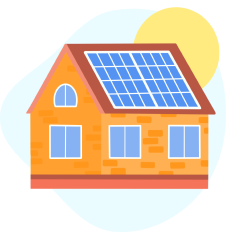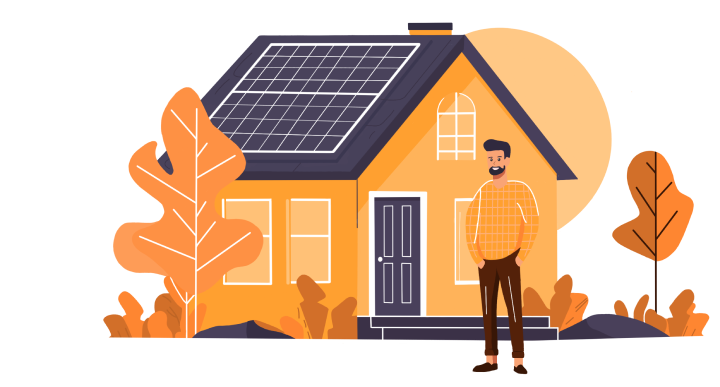A solar energy installation is a long-term investment in sustainability and energy savings. For busy and budget-conscious homeowners, however, switching to green energy can seem daunting. From figuring out the average solar energy installation cost to wondering if your roof can accommodate a hefty solar battery storage system, there are lots of things to consider.
Luckily, Solar Energy Host is here to help you find reputable solar installers in your area. Embrace the future with confidence, and let solar energy installation be your gateway to a more sustainable and cost-effective lifestyle.
#1: Assess your home's solar energy potential before starting installation.
How does solar energy work? A solar energy installation thrives in areas where consistent sunlight is a given, but even homes in cloudier regions can still harness solar power effectively. Check the amount of direct sunlight your home enjoys seasonally to get a realistic idea of potential energy output.
Check your roof's condition and space to ensure it's ready for solar panels.
Your roof must be structurally sound and have enough space to support the number of panels required for your energy needs. If your roof has seen better days or shows signs of wear and tear, addressing these issues before a solar energy installation is a must. A thorough roof inspection can spotlight any vulnerabilities or limitations that might impede the solar installation process.
Know your home's energy needs to choose the right system size.
Start by reviewing your household's energy usage over the past 12 months to gauge what you typically consume. The solar energy installation should be proportionate to your average consumption, ensuring you gain the most from your energy savings. This also allows you to consider add-ons to the cost of installing solar panels, like battery storage, to manage excess energy efficiently.
#2: Break down the solar energy installation process into clear, actionable steps.
A trained installer will visit your home to evaluate key factors like your roof's orientation, tilt and the amount of shade it receives throughout the day. They will also review your home's electrical system to ensure it is compatible with a solar energy installation. This allows your preferred clean energy provider to install solar that is tailored to your home's location and energy requirements.
Prepare for the installation process with minimal disruption to your routine.
Once you've chosen an installer and solar panel system, the actual solar energy installation generally takes a few days. They will install a solar panel system on your roof, connect them to your electrical system and install necessary equipment like inverters or battery storage.
Complete the necessary permits and approvals for solar installation.
Local authorities or homeowner associations often require specific permits for solar energy projects, and your installer typically handles these applications. Stay in the loop to confirm that all necessary approvals are secured. Also, utility companies may need to inspect the installation and give the green light for grid connection to ensure everything meets regulatory standards.
#3: Consider the financial benefits of solar energy and available incentives.
While solar energy requires an initial investment, the long-term savings on your energy bills can provide a strong return on investment (ROI).
Most homeowners can recoup their investment within five to ten years, depending on the size of the system, local electricity rates and available incentives. The key factors determining ROI include the amount of sunlight your location receives and the overall efficiency of the installed system.
Over a system's typical 25-year lifespan, the cumulative savings can significantly exceed the initial cost of solar panel installation, making solar energy not just an eco-friendly choice but a financially savvy one as well.
Explore solar energy benefits, like credits and incentives, to reduce upfront costs.
Federal, state and local governments often offer solar power incentives and rebates or tax credits to encourage homeowners to install solar energy systems.
For instance, the federal investment tax credit (ITC) allows you to deduct a significant percentage of your solar panel costs from your taxes, with additional state and local incentives potentially available.
You may also qualify for solar loans, leasing options and power purchase agreements. Seek guidance from your installer on how to apply to make the transition to solar energy more affordable.
#4: Choose Solar Energy Host to simplify your solar installation process and save money.
Solar Energy Host connects you with top-rated local installers to ensure quality installation.
We connect you with licensed and experienced professionals in your area who provide high-quality installations at competitive prices. These vetted solar power installers have a proven track record of successful solar installations, ensuring your system is both reliable and efficient.
Our platform lets you receive and compare quotes from several local installers, simplifying your decision-making process. You can identify the best combination of quality, cost and service to fit your specific needs and budget.
From the initial assessment to post-installation support, our platform is designed to make your transition to solar energy smooth and worry-free.
Frequently Asked Questions (FAQ)
How much space do I need for a solar panel installation?
The space needed for a solar energy installation varies with energy consumption and panel size. 1 kW solar installations typically require about 6–8 square meters of roof space.
For a standard residential system, which may be around 6 kW, you may need approximately 30–50 square meters. Check your roof for any possible obstructions, such as chimneys or vents, that could hinder installation, and optimize placement accordingly.
What warranties are typically offered for solar panels?
The product warranty ensures that the panels will still generate a significant portion of their rated output even after a set period, usually a couple of decades.
Meanwhile, the product warranty covers defects in materials and workmanship, and generally, the coverage period could vary from ten to 25 years. Some manufacturers may also provide extended warranties, offering additional peace of mind for your investment.
Is it possible to go completely off-grid with solar panels?
Going completely off-grid with solar panels is feasible but requires meticulous planning and extra equipment.
An off-grid system uses battery storage to save excess energy produced during the day for use at night or during cloudy periods. To achieve full off-grid capability, you'll need a larger solar array and substantial battery storage to cover your energy needs during times of limited sunlight. Incorporating backup power sources can help during prolonged periods of low sunlight.
Enjoy significant savings with Solar Energy Host
At Solar Energy Host, we're your trusted partner for practical, eco-friendly solutions. Our user-friendly platform connects you with top local providers, ensuring you receive competitive quotes for solar panel installation.
Join countless homeowners in reducing electricity bills and achieving a sustainable future. Start saving today with Solar Energy Host.




















